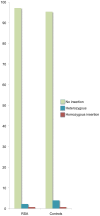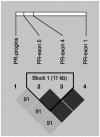Role of progesterone receptor polymorphisms in the recurrent spontaneous abortions: Indian case
- PMID: 20090851
- PMCID: PMC2806831
- DOI: 10.1371/journal.pone.0008712
Role of progesterone receptor polymorphisms in the recurrent spontaneous abortions: Indian case
Abstract
Background: We attempt to ascertain if the 3 linked single nucleotide polymorphisms (SNPs) of the Progesterone Receptor (PR) gene (exon 1: G 1031 C; S344T, exon 4: G 1978 T; L660V and exon 5: C 2310 T; H770H) and the PROGINS insertion in the intron G, between exons 7 and 8, are associated with Recurrent Spontaneous Abortion (RSA) in the Indian population.
Methodology/principal findings: A total of 143 women with RSA and 150 controls were sequenced for all the 8 exons looking for the above 3 linked SNPs of the PR gene earlier implicated in the RSA, as well as for any new SNPs that may be possibly found in the Indian population. PROGINS insertion was screened by electrophoresis. We did not find any new mutations, not observed earlier, in our population. Further, we did not find significant role of the *2 allele (representing the mutant allele at the three SNP loci) or the T2 allele (PROGINS insertion) in the manifestation of RSA. We also did not find an LD pattern between each of the 3 SNPs and the PROGINS insertion.
Conclusions/significance: The results suggest that the PR gene mutations may not play any exclusive role in the manifestation of RSA, and instead, given significantly higher frequency of the *2 allele among the normal women, we surmise if it does not really confer a protective role among the Indian populations, albeit further studies are required in the heterogeneous populations of this region before making any conclusive statement.
Conflict of interest statement
Figures





References
-
- Reiss HE. Reproductive Medicine: From A to Z. Oxford: Oxford University Press; 1998.
-
- Lanasa MC, Hogge WA. X chromosome defects as an etiology of recurrent spontaneous abortion. Semin Reprod Med. 2000;18:97–103. - PubMed
-
- Clarke CL, Sutherland RL. Progestin regulation of cellular proliferation. Endocr Rev. 1990;11(2):266–301. - PubMed
-
- Pepe GJ, Albrecht ED. Actions of placental and fetal adrenal steroid hormones in primate pregnancy. Endocr Rev. 1995;16(5):608–648. - PubMed
Publication types
MeSH terms
Substances
LinkOut - more resources
Full Text Sources
Research Materials

